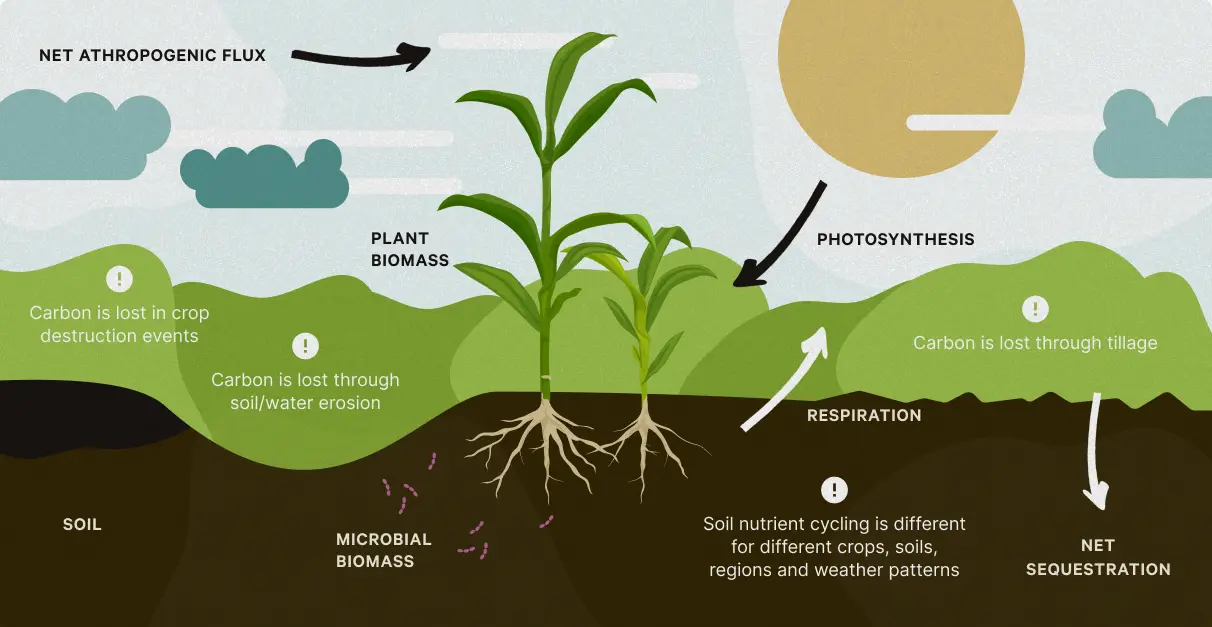But we should do it anyway.
“The reality of soil carbon is that it is highly variable, hard to measure, hard to shift and easy to lose.” — the Guardian
Soil carbon is a complex issue, but that doesn't mean we can afford to ignore it. In fact, we should increase the scale of carbon removals to help combat the impacts of climate change and create a more resilient food system.
How does carbon sequestration work?
Soil carbon is part of the “fast cycle” land carbon pool. CO2 from the atmosphere is “fixed” into complex organic molecules through the photosynthetic reaction of plants. This carbon can then be sequestered in the soil through plant structures such as roots, or through the decomposition of plant material in the soil. Naturally, some of this carbon is returned to the atmosphere during plant decomposition. However, regenerative practices such as crop rotation, planting cover crops, reduced- or no-till farming, and precision nutrient management can help facilitate the sequestration of carbon in the soil.

Because soil is a complex, dynamic system, accurately determining soil carbon is difficult. The variability of soil properties across a single field can make quantification variable and therefore difficult. The dynamics of the “fast-carbon” land cycle also mean that not all soil carbon removals are permanent. This lack of permanence means we can never guarantee the maximum benefit of soil as a carbon sink.
When combined, the uncertainties of accurate quantification and the lack of permanence provide vocal opponents of soil carbon removals avenues to oppose them and the market assets created from them. These opponents of soil carbon removals use the messiness of soil carbon to create confusion for parties looking to scale carbon removals on working lands. This confusion becomes counterproductive to meeting climate goals when it leads to paralysis and inaction.
The uncertainties around soil carbon removals are not an excuse to ignore them altogether. The impacts of soil carbon sequestration are not zero. Increases in soil organic carbon help promote increased soil health, microbial diversity, and water retention. These benefits are reflected in increased crop resilience, a necessary adaptation to the impacts of climate change. Soil carbon removals are not a climate mitigation silver bullet. But, they can provide both mitigation and adaptation and are a critical tool for helping to combat the climate crisis.
Many stakeholders in the agrifood value chain have begun incentivizing farmers to adopt practices that result in soil carbon sequestration. These incentives help reduce the economic barriers to adopting sustainable farming practices, while providing companies the opportunity to reduce their carbon footprint, and shore up their supply chains whilst meeting corporate ESG and net-zero targets. These investments in the farmers at the beginning of the food value chain also help to ensure the stability of an abundant food supply in the face of climate change.
Regrow has a better way to measure soil carbon.
It’s more dynamic, more accurate and less risky.
At Regrow, we use a scientific model called DeNitrification - DeComposition (DNDC) to estimate the current soil carbon levels and how they may change with the adoption of new farming practices. This model, developed by soil scientists at the University of New Hampshire and shared with a global research community, has appeared in more than 500 peer-reviewed studies.
This model is validated with ground-truth data and calibrated at a global scale. It allows us to estimate the impact of our efforts with a scientifically rigorous level of accuracy.
As we continue to utilize, calibrate and validate this model — and indeed, as other models in the industry evolve — soil carbon measurements will continue to become more accessible, more scalable and more holistically reliable.
Science and investment will pave the way for certainty in the industry.
Yes — soil carbon is hard. It’s a nuanced practice that changes as our farm management practices change, and as science improves. However, the difficulty of the practice does not make it impossible or unreliable, neither does it negate the positive climate impact it creates.
On the contrary: soil carbon modeling is the only quantification methodology that can scale to meet our climate change mitigation goals. The science behind soil carbon modeling is progressing quickly, and research continues to underscore its value in the future of our food systems. In fact, it is the difficulty of soil carbon removals that makes the case for increased research and support. The private sector is investing heavily in new technologies to better measure and model soil carbon. In the US, the government has invested billions in advancing climate smart agriculture through both the Climate Smart Commodities program and the Inflation Reduction Act. These historic investments in climate smart ag will greatly improve our ability to create rigorous, credible soil carbon removals.
With the continued investment in soil health practices and building soil organic carbon as one of its components the industry seeks to assure the fragile supply chains that the world depends on for nourishment.
Learn more about our science and see an example of this work in action.
.png)


